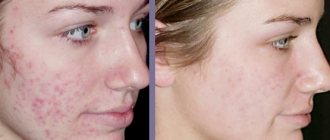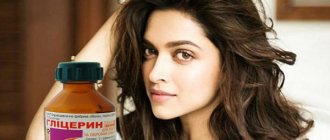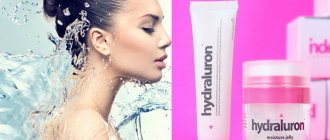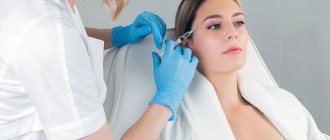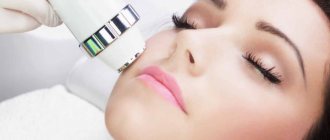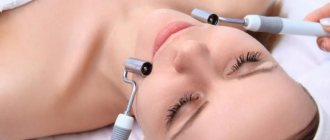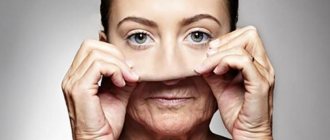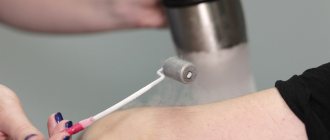Device for photorejuvenation M22 based on IPL
The M22 device produces IPL-type photorejuvenation and a number of other manipulations from the arsenal of photocosmetology. This is a professional-grade multi-module platform that is used to treat aesthetic skin imperfections. The equipment is developed and manufactured by Lumenis, a large international manufacturer of cosmetology equipment.
The advantage of the M22 model is its dual pulse system. Nd:Yag (neodymium laser) and IPL, which expands its functionality. High operating efficiency is ensured by a special beam configuration and cooling system, which increase the effectiveness of manipulations while ensuring a high level of patient safety.
Where to do facial photorejuvenation?
In aesthetic medicine, cosmetologists use light methods carefully, since if the skin type is incorrectly determined or the devices for the procedure are selected incorrectly, there is a high probability of developing complications. To avoid regretting your choice, contact only qualified doctors who have been specially trained and have gained relevant experience in photocosmetology
The Areado portal has collected the best cosmetology salons in Russia providing photorejuvenation services. To start selecting a salon in a suitable area or near a metro station, select one of the cities.
- Moscow;
- St. Petersburg;
- Novosibirsk;
- Yekaterinburg.
It is preferable if the cosmetologist is certified in the field of laser technology and has received a certificate from the manufacturer of the device with which he works. The light treatment device deserves special mention. The more modern the device used by the doctor, the higher the chances of a good effect for the patient.
Modern models are equipped with automatic high-precision diagnostics. This helps the cosmetologist select the appropriate intensity of the rays. Preset programs, replaceable filters and emitters allow the program to be adjusted for each patient. You can find out the name of the device by calling the clinic or looking at the website.
It is worth noting that the procedure will be more expensive when using professional equipment.
Photorejuvenation: contraindications
You need to understand that this procedure affects the processes occurring in skin cells, therefore there are a number of contraindications to its implementation. For the most part, they are standard for all cosmetic procedures, but there are some differences:
- Age up to 16 years, because hormones are unstable up to this point, and the procedure can lead to unexpected negative effects;
- Pregnancy and lactation - the “play” of hormones, as mentioned in the previous paragraph, can negatively affect the result;
- A tan, which is essentially a burn, a microtrauma, is also a contraindication to photorejuvenation of the skin;
- Eye diseases such as glaucoma and cataracts. Light exposure, despite all safety measures, can negatively affect the development of these diseases;
- In case of any inflammatory processes, cosmetic intervention is undesirable, because the situation may get worse. Impact on unhealthy areas of the skin, for example, with psoriasis, dermatitis, allergic manifestations, is absolutely contraindicated;
- Mental and nervous disorders are contraindications to photorejuvenation;
- When taking antibiotics, photorejuvenation is undesirable, because the result may simply not appear due to the stopping of anti-aging processes by medications;
- Oncological diseases are a serious factor for refusing the procedure. Your health is unstable, therefore, it is better to hold off on cosmetology.
The list of contraindications to photorejuvenation is quite clear, but what consequences may arise?
Indications
The main indications for the procedure are described below.
Removal of freckles and age spots
Phototherapy does not lighten excess pigmentation, like other methods, but removes it. Light rays heat age spots and freckles without destroying surrounding tissue. After the procedure, they darken, and after a while this area begins to peel off. The new layer has a normal shade, which is no different from healthy epidermis. To completely disappear pigmentation, it is necessary to carry out from 3 to 10 procedures with a break of 2-3 weeks. The number of sessions is determined by the cosmetologist depending on the skin type, type and size of pigmentation.
The effect of the first procedure will be noticeable after 10 days.
Acne treatment
Acne occurs due to an inflammatory process in the sebaceous gland. During phototherapy, the damaged area is heated. Thanks to this, bacteria are destroyed, the synthesis of collagen and elastin is stimulated, and the skin is quickly restored. On average, the course of treatment is 5-10 sessions. Immediately after the procedure, the area of skin may become inflamed and swollen, which is a normal reaction. This condition will pass in a few hours.
After completing the course of treatment, the complexion becomes healthy, acne and spots from them disappear.
Removal of vascular formations
Under the influence of the beam, pathologically dilated capillaries close, while healthy ones remain intact. Elastin and collagen begin to be actively produced, which accelerates healing and tightens the skin. Depending on the size and type of damaged vessels, the number of procedures is determined (on average 5-8). After completion of treatment, it is recommended to perform 1-2 procedures per year to prevent the formation of new vascular disorders.
Other indications
Also, the photorejuvenation procedure will be effective for:
- the first wrinkles and other age-related changes that occur after 30 years;
- unhealthy (gray or yellow) complexion;
- dryness, tightness, peeling of the skin;
- excessive oily skin;
- enlarged pores.
What disadvantages does photorejuvenation eliminate?
Photorejuvenation is one of the most effective procedures for eliminating skin problems resulting from photoaging. Age spots and keratosis, enlarged pores and spider veins, earthy complexion and rosacea, fine wrinkles and loss of skin elasticity begin to appear after 30-35 years
.
At this age, photorejuvenation will require a minimum of procedures
to get rid of imperfections that affect your appearance. In adulthood, more procedures will be needed to combat photoaging.
Excessive dryness of the skin or, conversely, increased oiliness, freckles, comedones, acne, acne and post-acne cause complexes at a younger age. Photorejuvenation procedures are not contraindicated in this case either, only with less frequency.
First of all, these problems prevent reconciliation on open areas of the body, so photorejuvenation procedures are most often in demand on the face, neck, décolleté, and hands.
Indications for photorejuvenation
Photorejuvenation is a modern, highly effective procedure for skin rejuvenation and treatment, which is based on the effect of intense pulsating light (Intensive Puls Light, IPL) on certain skin structures, depending on the selected light wavelength and radiation parameters. The targets of action in this case are melanin deposits in the skin, components of dilated blood vessels and defective collagen fibers. The light energy of IPL radiation causes the destruction of these structures without damaging the surrounding tissue.
The photorejuvenation procedure in our clinic is performed on one of the most powerful and effective devices today - the multi-module M22 platform (Lumenis), which is a newer, improved version of the famous IPL Quantum device, released by the same company about 12 years ago. Only procedures performed on high-quality, modern equipment can guarantee the safety of the procedure and excellent results!
- Skin withering, decreased tone;
- Age spots, freckles;
- Age-related hyperpigmentation;
- Vascular networks, telangiectasia;
- Enlarged pores;
In addition, by warming the dermis, the growth of the skin's own young collagen is stimulated, and microcirculation of blood and lymph improves. All this leads to skin tightening and improving its quality.
In order to accurately determine whether the photorejuvenation procedure is indicated for you, you need to make an appointment with a cosmetologist, who will not only assess the need for the procedure and select an individual treatment program, but also give additional recommendations that will make the treatment procedure as effective as possible and preserve the result for a long time.
The price of photorejuvenation depends on the area being treated and the desired result.
What types of photorejuvenation exist?
Photorejuvenation can be divided into two types, ELOS and Quantum, which differ in the methods of exposure and the effects they provide. Quantum is a quick removal of age spots, the procedure takes little time and causes a minimum of side effects, such as swelling and redness, for example. ELOS is a deeper effect, which is also called true photorejuvenation; its consequences, if the cosmetologist is incompetent, can be more pronounced. The laser destroys hemoglobin in the skin capillaries, replacing it with connective tissue, i.e. manipulations are carried out with the structure of the skin, with the reasons for the appearance of skin imperfections.
What result will you get after the session?
During the procedure, the cosmetologist moves a special device over the skin, which emits powerful flashes of light. They penetrate to a depth of 3 cm, gently warm the tissues and work at the cellular level. Such targeted impulses help the skin rebuild itself and improve its condition - photorejuvenation works with several problems at once.
What changes will you notice after the course:
- Natural skin rejuvenation. The procedure accelerates living natural processes, so the skin becomes healthier and truly younger. After a course of photorejuvenation, cells begin to intensively produce their own collagen and elastin. Due to this, the oval of the face is tightened, wrinkles and scars are reduced, and pores are narrowed.
- Even complexion – pigment spots lighten or disappear. Powerful flashes destroy excess melanin pigment, and after 5-7 days the skin color becomes healthy and even.
- Spider veins and rosacea go away. Light radiation also acts on capillaries, contracting them. The reddish mesh on the cheeks and wings of the nose becomes less noticeable, and this visually makes you look several years younger.
- The skin becomes healthier and closer to normal. The procedure has pleasant “side effects”: under the influence of light, inflammation and herpes on the skin heal faster, and acne goes away. You will be less bothered by oily shine or, conversely, skin tightness.
Feature of the procedure
The process of facial photorejuvenation goes like this. A specialist with a medical education uses a device to treat areas of the skin. The impulses created by the device reach the deep layers of the epidermis, where they are absorbed by melanin. Under the influence of radiation, collagen and elastin begin to be naturally produced in the skin. As a result, the patient’s face will become more toned after just a few procedures. Radiation contributes to the following: acceleration of metabolism, resorption of fat deposits, smoothing of wrinkles.
To enhance the effectiveness of the effect, before using the device, the doctor applies a special cosmetic preparation. Its composition is determined based on the individual characteristics of the patient’s skin.
Facial photorejuvenation refers to complex solutions aimed at improving skin condition. Therapy is carried out using one of several techniques. Each of them uses different types of devices capable of producing radiation of a certain power. A patient who goes to a beauty salon or clinic where photorejuvenation will be offered one of the following ways to improve skin condition:
- laser phototherapy of the face using a neodymium laser;
- treatment using intense light radiation of different wavelengths;
- a comprehensive solution including ELOS procedures and electrical stimulation;
- collagen version of the effect, involving the use of special lamps.
Important! It is highly undesirable to subject your facial skin to photorejuvenation in the summer. At this time, its sensitivity to ultraviolet radiation increases. In this regard, it is better to make an appointment with a specialist in the fall or spring.
In each of the presented cases, the device used to carry out the photorejuvenation procedure supplies energy in separate beams. Getting into the epidermis, it increases the temperature of individual compounds, which will ultimately cause their destruction. The high sensitivity and precision of the device settings ensure that the impact does not harm muscle tissue. They retain their integrity during any number of procedures.
Possible complications
Laser lifting is a relatively gentle method of rejuvenation. However, there remains a possibility of complications and unpleasant consequences. Side effects occur in 3-5% of cases. These include the following negative points:
- skin redness;
- severe itching;
- severe swelling;
- formation of weeping crusts;
- preservation of “holes” from the fractional laser;
- hypo- or hyperpigmentation;
- the appearance of scars;
- bruises;
- skin inflammation.
Most symptoms resolve within the first week of rehabilitation. If the sensations become excessively painful, the itching does not go away, new wound lesions appear, you should immediately seek help from a specialist.
How many neck photorejuvenation procedures need to be done?
In some women, it is the neck that shows age, where the skin is thinner and without subcutaneous fat. After 30 years, the neck loses its elasticity, the skin sags and becomes flabby, or deep transverse wrinkles appear. In addition, tan marks do not reflect well on the middle-aged skin of the neck.
To correct signs of age on the neck, photorejuvenation is an effective procedure. One session lasts 30-40 minutes.
Depending on the initial condition of the skin and the surface area requiring correction, the specialist decides how many procedures need to be done.
Usually, to solve all problems, a course of 5-6 neck photorejuvenation procedures
with an interval between them of approximately 4 weeks.
Cost of neck photorejuvenation
1 procedure in Moscow will cost from 3,500 to 8,000 rubles.
How photorejuvenation occurs - what to combine with
The facial photorejuvenation procedure occurs in several stages. The preparatory stage is cleaning the patient’s face and applying a layer of light-conducting cooling gel. After this, the cosmetologist, starting the procedure, protects the woman’s eyes with special glasses with powerful light filters. The duration of the manipulations ranges from 15 to 60 minutes.
The affected area is treated with photo flashes, according to the selected mode. One procedure involves two simultaneous effects that affect the superficial layers of the skin, warming up the deep inner layers. Flashlights are virtually painless.
Some unpleasant sensations are felt in the area of the nasolabial triangle.
The session ends with the application of an anti-inflammatory agent, after which the cosmetologist gives recommendations for the rehabilitation period. These include:
- do not sunbathe for a week, use sunscreen;
- refuse to visit a bathhouse, sauna, or perform procedures related to heating the skin (thermal masks, inhalations);
- Do not use foundation, powder, or aggressive cleansers with acids and alcohol for several days;
- refrain from alcohol, smoking, strong physical activity, drink more water - to maintain the water balance of facial tissues.
Photorejuvenation can be performed annually. The procedure is combined with techniques such as peeling, mesotherapy, Botox or Dysport injections, and contouring. It is only necessary to maintain a sufficient time interval.
Cosmetologists advise to first carry out light therapy, and after six months begin contouring. Mesotherapy or peeling will force you to postpone photorejuvenation for 2-3 weeks. Botulinum toxin injections should be carried out 2 weeks after photo treatment; combining these two procedures on the same area is strictly prohibited.
The number of sessions ranges from 3 to 7 with a break of up to 3 weeks. The duration of the course depends on the skin type, its condition, and the patient’s age. Less powerful home devices may delay the onset of the effect, so more sessions will be required. However, professional equipment, which includes the IPL-based M22 model, makes it possible to correct deficiencies in a limited number of sessions.
ELOS – rejuvenation
ELOS, which is partly photorejuvenation, can also be considered an innovation among anti-aging technologies.
ELOS - rejuvenation is new because the energy of RF radio waves is added to the action of IPR - light quanta. Thanks to this powerful complex, the effectiveness of the procedure greatly increases.
The technology is intended, like photorejuvenation, to eliminate unwanted symptoms of skin aging.
So far this is the most effective method of dealing with time, at the same time painless and quite pleasant.
It also has a healing and life-giving effect, accelerating the healing of scars and wounds, and combats acne and oily skin.
The consequences of the ELOS procedure are similar to photorejuvenation:
- tightening and increasing the tone of the epidermis;
- elimination of wrinkles;
- restoration of healthy color and normalization of sebum secretion of the skin; reduction of pigmentation, capillary “stars”;
- activation of metabolism, etc.
The differences between ELOS and photorejuvenation are only in the power of impact: the first technique has a faster result due to its bidirectional effect. These procedures are good for eliminating facial wrinkles.
Side effects and recovery period
If you decide to undergo photorejuvenation, the pros and cons of the procedure should also be carefully weighed. First of all, you need to take into account that after the session there may be side effects. The most common effects include significant redness, soreness, swelling, and then dryness of the skin. If safety precautions are violated during the procedure, skin burns are also possible.
In order to minimize potential risks, it is recommended to choose a specialist as carefully as possible, paying attention not only to his experience, but also to the devices that are in his charge
In addition, it is extremely important to follow the recommendations for the recovery period. In most cases, they are:
In most cases, they are:
- applying panthenol to the skin 2 times a day;
- using special nourishing cosmetics;
- conducting repeated sessions with a break of at least one week;
- limiting exposure to high temperatures (hot water) and direct sunlight;
- minimizing the use of decorative cosmetics.
How many hand photorejuvenation procedures need to be done?
Hands, in addition to natural influences, also take on chemical influences when they come into contact with detergents and other substances. Therefore, even with proper care, tightness and dryness of the skin appears, gradually turning into sagging and wrinkled hands. Out of nowhere, pigment spots and some growths appear on the skin, so unsightly that they reveal their true age.
Unpleasant changes that occur on the hands can be corrected using a photorejuvenation procedure. It takes no more than 20 minutes. and after it you can immediately go about your usual activities.
How many photorejuvenation procedures do you need to do to restore the beauty of your hands?
To gradually but effectively restore the youthful condition of the skin of the hands,
2-3 phototherapy procedures
with an interval of 3 weeks. With this approach to treatment, photorejuvenation will not have harmful effects on the skin.
If we focus on the cost of the photorejuvenation procedure for the hands
in Moscow, then it will be from 3000 to 6000 rubles. In other cities of Russia, the cost may be two times less.
A high price does not always mean a better result: sometimes clients have to pay for expensive equipment and the prestige of the establishment. At the same time, a low price in some cosmetology center is not only a marketing ploy, but the result of the use of unprofessional equipment.
Answers on questions
How many procedures are needed to achieve a visible lifting effect?
The result will be noticeable after the first manipulation, when the skin is restored. However, to achieve a lasting and maximum result, another 2-3 sessions are needed, carried out at intervals of 1-1.5 months.
Can laser lifting replace plastic surgery?
This method allows you to achieve an effect similar to a surgical lift, but still it will not be as long-lasting and of high quality. If there are significant signs of aging, it is better to seek the help of a plastic surgeon.
How much does laser lifting procedure cost?
The exact price depends on the number of treated areas and the chosen method, the rating of the clinic and the skill level of the specialist. On average, a face and neck lift requires about 50 thousand rubles.
Is it possible to carry out the procedure at home?
There are devices on sale for home use, but their efficiency is significantly lower than professional equipment. In addition, without medical supervision it is difficult to achieve a high-quality result; there is a high risk of complications.
How many procedures does the course consist of, and how much will it cost?
The price and duration completely depend on what skin problems you have, in which cosmetology center and with which device the facial photorejuvenation is performed. Reviews and contraindications can be found on forums, as well as on beauty salon websites. It is advisable to choose those establishments where the price is indicated for 1 flash, because this way you can save money if the problems are minor. On average, a course can consist of 4-6 procedures. One flash will cost approximately 400-700 rubles, and complete rejuvenation of a certain area of the face ranges from 2000 to 7500 rubles.
What is photorejuvenation
The essence of this service is to combat age-related changes in appearance. Most often, photorejuvenation is used for the face - cheeks, forehead, chin, nasolabial triangle.
Laser photorejuvenation of the face promotes cell renewal and stimulation of collagen synthesis, due to which, as numerous reviews indicate, the skin becomes perfectly even, elastic, smooth, and fine wrinkles disappear.
For the procedure, the innovative M22 device is most often used, which produces pulsed light, which, acting on the face, removes dead cells of the upper layer of the dermis. The luminous flux does not contain the UV spectrum.
Facial photorejuvenation can be divided into four types:
- Elos. The technique combines electrical and photorejuvenation. Many cosmetologists believe that there is no alternative to Elos.
- Laser. The light source is a neodymium laser.
- Collagen. Collagen lamps are used to stimulate collagen synthesis.
- IPL devices for photorejuvenation. The use of powerful light pulses that affect the skin with frequent flashes of rays of a certain intensity.
A woman who decides to undergo photorejuvenation needs to consult with a cosmetologist who will advise which type of procedure is right for her. It should be noted that the price of the procedure also depends on the technique.
Description of the procedure.
The procedure must be preceded by a preparatory stage, otherwise the effect will be reduced or not achieved at all. So, a month before photorejuvenation, it is not recommended to visit the beach, solarium, or use self-tanning products. The doctor is obliged to find out whether there are contraindications.
Carrying out the procedure:
- The patient lies down on the couch.
- A special gel is applied to the treated areas of the skin, which has a cooling effect.
- The patient and the cosmetologist put on dark glasses. The flash is visible even through dark glasses, which creates some discomfort. With Elos rejuvenation there is no negative effect on the eyes.
- The cosmetologist begins to make laser flashes.
- At the end of the procedure (duration about an hour), the dermis is treated with panthenol.
Patients are often afraid that photorejuvenation may cause pain. Reviews from girls who have tried this procedure indicate some unpleasant sensations - tingling and burning, which are most often concentrated in the area of the lips and wings of the nose. Redness may be observed, which disappears within an hour and a half.
Undoubted advantages of photorejuvenation:
- when eliminating defects, the surface of the skin is not damaged;
- procedures have a cumulative effect.
Contraindications
The procedure is contraindicated in the following conditions:
- taking isotretinoin during the last six months; these medications are used primarily to treat severe acne and include Acnecutane, Verocutane, Roaccutane, and Sotret;
- photosensitivity – increased skin sensitivity to sunlight, which occurs when taking many medications, skin diseases, systemic rheumatological diseases and other conditions;
- epilepsy;
- photodermatosis accompanying a disorder of pigment metabolism (porphyria);
- pregnancy;
- malignant neoplasms or suspected skin cancer;
- acute infectious diseases, viral infection;
- severe concomitant illnesses, such as high blood pressure or heart failure.
Photoporation is allowed for patients with an existing pacemaker, since it does not have an electrical or magnetic effect on the body. In each case, the question of prescribing a course of photoporation is decided individually. Before the procedure, a consultation with a cosmetologist is required.
How the procedure is carried out in the salon
First of all, you should initially go for a consultation to find out what types of laser rejuvenation are done in a particular salon, talk to the specialist, make sure of his professionalism - see with your own eyes the diplomas, certificates, and the place where everything will happen. And also prepare yourself mentally. It is not recommended to do the procedure right away - it is better to prepare yourself first, and talking with a doctor is one way to achieve this.
Moreover, before facial rejuvenation with a laser in Moscow or other cities, it is not recommended to sunbathe for 4 weeks, do peelings, cleansing or other, even rejuvenating, procedures in a salon. A couple of days in advance, you should stop using decorative cosmetics, and a day before, do not apply cream. You need to come to the clinic with a clean face, but you don’t need to do any special cleansing - regular washing is enough.
A scrub or peeling will be done for you in the salon yourself, after which anesthesia will be applied in the form of a gel. The master selects the depth of the laser and its temperature depending on the client’s skin type and his problems. And then, in fact, everything happens - the longer the rays and the larger the surface of influence, the more painful it will be. Next, the skin areas are treated with a specialized lotion, again they will give instructions and talk about care.
You should not go to work after the procedure; it is better to rest at home. If an area of the cheeks, nose or chin has been treated, it is advisable to wear a medical mask when going outside.
The rejuvenation procedure is shown in detail in this video:
How to choose the right doctor
Initially, you should make sure that the chosen clinic (or beauty salon) employs doctors who actually have the right to provide photorejuvenation services, and familiarize yourself with their certificates and diplomas.
Then you should turn your attention to the room itself and the equipment. Despite the modern development of medicine, a high-quality photocosmetic instrument is quite impressive in size; it is a rather bulky mechanism; it cannot be in a pocket format.
Of course, one of the important nuances is the attitude of the staff towards the client. In a good cosmetic clinic (or salon), a card is created for each new patient, which records the minimum necessary information about the client’s health and directly about the procedures that have already been performed. Also, contraindications (if any) must be recorded, and the nuances of the period of skin preparation and its recovery after photorejuvenation must be discussed.
The client should be aware that there cannot be an immediate result; for a sustainable desired effect, as a rule, 6 to 8 procedures are required, while one procedure can be performed approximately once a month (this is determined on an individual basis). After this, the patient should be offered a maintenance regimen, which involves one or two procedures per year.
An important issue is payment. In some cases, the payment may be fixed (depending on the skin area), sometimes it is tied to the number of flashes. Some clinics (or salons) pay separately for the use of a restorative cream (panthenol or its equivalent), which should be applied to the skin immediately after treatment. Pain relief is also paid separately if it is used during the procedure. In addition, some clinics charge a separate fee for a doctor’s consultation. Many clinics offer a fairly flexible and loyal system of discounts. For example, if you order photorejuvenation of several zones at once, it will be much cheaper than if you order each service separately. Sometimes clinics hold promotions that offer discounts, this is possible for various reasons.
How is photorejuvenation performed?
Preparing for the session
Before carrying out the procedure itself, you should carefully prepare for it. Not only the result, but also the prevention of complications depends on how conscientiously the client treats the preparation. So, before the session you should follow the following recommendations:
- it is necessary to consult a specialist about the possibility of using photorejuvenation in a particular area;
- 3-4 weeks before the procedure, you must stop tanning (both solar and artificial);
- 3-4 days before the session you should not visit the sauna, bathhouse or swimming pool.
Important! The photorejuvenation procedure cannot be done in the summer during periods of increased solar activity!
Progress of the procedure
- The skin must be cleansed of dirt and decorative cosmetics.
- The client should wear protective glasses over his eyes.
- A cooling gel is applied evenly to the treated areas.
- If the procedure is performed for the first time, then it is necessary to do 2-3 test flashes to determine how the skin reacts to the impulses. If the reaction is normal, you can begin to fully treat the problem areas. A slight burning and tingling sensation is considered normal.
- Using a special device, a specialist must go over the entire surface. Each area is allowed to be affected only once. One session can last 15–60 minutes. The larger the skin area being treated, the longer the procedure lasts.
- After the end of the light beam, you must remove the remaining gel and glasses.
- A soothing agent (for example, Bepanten cream) is applied to the areas where the high-pulse light “worked.”
The first changes can be noticeable after the first procedure - the skin becomes softer, the tone is evened out. However, the expected result will not appear immediately. To do this, you should complete a course of 4–6 sessions, the interval between which is 1 month.
With each subsequent session, the power of the light pulse can be increased to affect deeper layers of the skin and thereby increase the effectiveness of the method.
You need to know that when pigment spots and freckles are removed after the procedure, they become much darker and become much more noticeable. However, already on the third day, pigment manifestations begin to fade and after 5–7 days they are practically invisible.
Skin care after the procedure
- For the first 2 days after photorejuvenation, it is better not to use aggressive cosmetics (especially foundation and powder). It is necessary to refrain from using lotions containing alcohol.
- For 3–5 days, morning and evening, it is recommended to apply a healing and soothing cream to the skin (Bepanten, D-panthenol, Dexpanthenol, etc.).
- In the first 2 weeks after the session, you should not sunbathe in the sun or in a solarium and overheat the skin (in a bathhouse, sauna). You should also not swim in a pool whose water is treated with chlorine compounds.
- For two weeks, before going outside, you must apply sunscreen with an SPF of at least 50 units.
- It is recommended to refrain from drinking alcohol. It destroys cell membranes, and this dries out the skin, which experienced quite significant stress during the session. Therefore, it is better to take a pause of 5–6 days. This also applies to smoking.
- It is necessary to observe the drinking regime - drink 1.5–2 liters of clean water per day.
Possible consequences of photorejuvenation
Despite the fact that photorejuvenation is a low-traumatic procedure, some unpleasant consequences, although rare (in 2% of cases), can still occur. The main reason for such side effects lies in non-compliance with skin care recommendations after the procedure, as well as in violation of the protocol of actions during photorejuvenation.
The main possible unpleasant consequences of photorejuvenation include:
- swelling and hyperemia: it is considered normal if after a session there is swelling or redness on the skin for 2-3 days. However, if swelling and hyperemia do not go away and persist for more than 3 days, you should contact the cosmetologist who performed the procedure. The specialist will tell you what measures need to be taken to eliminate side effects. These are mainly contrasting compresses and lotions made from medicinal herbs;
- bruises: extremely rarely, hematomas may appear on the surface of the skin; most often this occurs due to incorrectly selected light output. Bruises can be eliminated using cosmetic whitening compounds or folk remedies (cream, sour cream, cucumber);
- hyperpigmentation: if after the procedure skin care recommendations were not followed and the skin was exposed to aggressive direct sunlight, then there is a high probability of pigment spots appearing;
- Photodermatosis: Overly sensitive skin may react to exposure to light by developing photodermatosis. This is an inflammatory reaction of the skin, in which rashes appear in the form of blisters, papules, erythematous spots, and an itchy red rash.
One of the unpleasant consequences of the photorejuvenation procedure is skin redness or hyperemia.
How is laser facelift performed?
A facelift using a laser depends on the client’s goals and wishes, on the chosen rejuvenation technique, and on the equipment used in the clinic.
Laser equipment
For laser facelift, non-ablative rejuvenation devices are used.
Laser radiation penetrates to different depths and has a specific effect, depending on the wavelength. Various laser devices solve their problems of facial skin rejuvenation.
The main task for an ablative laser is water, which evaporates from tissues during the procedure.
Laser peeling is a painful procedure that requires longer rehabilitation. But this is also the best face lift. Specialists choose fractional lasers for this procedure.
How to do photorejuvenation at home
Doing laser rejuvenation on yourself is not that difficult, the main thing is not to save on purchasing systems. Many companies provide their customers with the opportunity to purchase portable or household laser systems suitable for private use. In addition to this, you should also purchase special conductive gels, nutritional and softening mixtures, and glasses (flashes are harmful to the eyes).
Good reviews about Silk'n Reju - a portable fractional laser for facial photorejuvenation with a built-in cream cartridge. Let's look at the process using it:
- The face must be cleaned of makeup and completely degreased with a mild tonic without alcohol;
- Then we tune the laser to the desired frequency (here it is very important to read the instructions in detail);
- We apply short bursts to the desired areas of the skin.
In addition to Silk Cut, girls often recommend the device from Lumenis - Quantum. This is the first laser epilator and anti-aging system of its kind, which helps to cope not only with problems of the face, but also of the body. The main advantage of the system is that it can be used on any area (many similar devices are not recommended for use in the groin). It is, of course, much more expensive than Rezhu, but it provides a wider range of services.
Photo - Face after photorejuvenation
Among domestic devices, we can note the YAKHROMA-MED laser device. This is a strictly medical device, which is unlikely to help with severe wrinkles, but it will remove the “cobwebs” at once. Its cost is quite low, but its effectiveness still leaves much to be desired.
The main difference between this system, for example from Palomar, is the principle of applying the cream. If there is no built-in cartridge, then you need to apply a thin layer of gel to problem areas; if there is one, then there is nothing to worry about.
